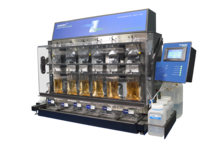
Dietary Fiber Analysis
Definition
A key nutrient for optimal gut health, dietary fiber is defined by the FDA and nutrition facts label as "non-digestible soluble and insoluble carbohydrates (with 3 or more monomeric units), and lignin that are intrinsic and intact in plants; isolated or synthetic non-digestible carbohydrates (with 3 or more monomeric units) determined by FDA to have physiological effects that are beneficial to human health." Soluble fiber foods, such as oats, apples, and beans, can be broken down by water, whereas insoluble fibers like flour, nuts, and vegetables cannot. Maintaining a healthy dietary fiber intake can improve digestion and lower one’s risk of diabetes, obesity, and heart disease.
Dietary fiber determinations in food and feed products need to be accurate and precise. Manufacturers, researchers, and regulatory boards require reliable nutrient information to meet standards and ensure food safety.
Methods
There are several AOAC methods that determine total dietary fiber as the definition of what constitutes dietary fiber has evolved over the years. The most known and used include:
AOAC 985.29, AOAC 991.43, AOAC 2001.03, (AACC 32.07.01), AOAC 2009.01, AOAC 2011.25, AOAC 2017.16, and AOAC 2022.01
Some methods allow the user to determine both the Insoluble Dietary Fiber (IDF) and the Soluble Dietary Fiber (SDF) fractions. AOAC methods 985.29, 2001.03, 2009.01, and 2017.06 determine Total Dietary Fiber (TDF) while AOAC methods 991.43, 2011.25, and 2022.01 measure both insoluble and soluble values separately. The method chosen depends on the definition of fiber components one would like to quantify.
AOAC 985.29/991.43 - Prosky / Lee Methods
The first AOAC method, AOAC 985.29 was developed in 1985 to fulfill the dietary fiber definition published by Trowel et al. in 1976: “Dietary fibre consists of the remnants of edible plant cells, polysaccharides, lignin, and associated substances resistant (hydrolysis) digestion by the alimentary enzymes of humans.” This method, considered the classical dietary fiber method, determines the total dietary fiber value in a sample, aside from resistant starches and non-digestible oligosaccharides.
While 985.29 is used to find the total dietary fiber value, AOAC 991.43 (otherwise known as the Lee Method) determines IDF and SDF. The sum of these finds for the total dietary fiber value. AOAC 991.43 is the most common method because it does not require later HPLC analysis. Natural food samples that have not been artificially fortified can be run efficiently by this method.
AOAC 2009.01/2011.25 - McCleary Method (CODEX)
Referred to as the McCleary Method, AOAC 2009.01 and 2011.25 find the dietary fiber components according to the CODEX Alimentarius. 2009.01 and 2011.25 are two of the most arduous methods for dietary fiber analysis, as specific temperature and digestion times are required to closely mimic human digestion. A pancreatic a-amylase treatment at 37°C simulates the conditions. Resistant starches are not hydrolyzed as in the Prosky method. After digestion is performed, further quantitation via chromatography such as HPLC is required.
AOAC 2017.16/2022.01 - Rapid Integrated Total Dietary Fiber
The Rapid Integrated Total Dietary Fiber (RINTDF) methods, AOAC 2017.16 and 2022.01, replicate the 2009.01 and 2011.25 CODEX methods but with a shorter digestion time and improving estimation shortfalls. The RINTDF methods drastically reduce digestion time from 16 hours to 4 hours. These methods measure all total dietary fiber components defined by the CODEX Alimentarius, including RS4.

Part #
Automated Dietary Fiber Analysis Automates AOAC 985.29, 991.43, and 2001.03 (AACC 32.07.01), and NMKL 129, 2003, AOAC 2009.01, 2011.25, 2017.16 and 2022.01 The ANKOM TDF Dietary Fiber Analyzer creates a new standard used for nutritional labeling...
